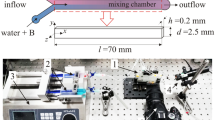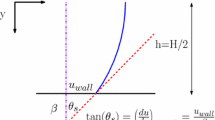Abstract
Typically, the flow through a microchannel network of a lab-on-a-chip device is viscous dominant. Concomitantly, the fluid transport is laminar and the intermixing of fluid layers is absent. Thus, it becomes a challenging task to rapidly homogenize different species within the limited spacial region available. In this context, to enhance the micro-mixing, we extend the work of Ranjith et al. [Soft Matter (2014), Microfluid. Nanofluid. (2015)] who suggested that a sudden drift in wall shear stress generates cross-stream momentum. Such microchannels are realized by periodically coating a hydrophilic wall with hydrophobic materials by keeping the orientation of these regions in the transverse direction to the pressure gradient. In the present study, the computational fluid dynamics is employed to investigate the convective mixing in Y-mixers decorated with such hybrid hydrophobic-hydrophilic surfaces. These microchannels are considered as a combination of several alternately repeating hydrophobic and hydrophilic patches which indeed modeled as an agglomeration of no-slip and partial-slip surfaces. Here, the improvement in mixing owing to the churning of species inside these channels in comparison with conventional hydrophilic confinement is examined in detail. We observed that, the lateral velocity generated throughout stripped channel promotes homogenization in comparison with its uniformly hydrophobic counterpart. In addition to that, the presence of hydrophobic surfaces reduces the hydrodynamic resistance offered by the channel, which in turn saves the pumping power significantly.













Similar content being viewed by others
References
Benzi R, Biferale L, Sbragaglia M, Succi S, Toschi F (2006) Mesoscopic modelling of heterogeneous boundary conditions for microchannel flows. J Fluid Mech 548:257–280
Bhagat AAS, Peterson ET, Papautsky I (2007) A passive planar micromixer with obstructions for mixing at low reynolds numbers. J Micromech Microeng 17(5):1017
Capretto L, Cheng W, Hill M, Zhang X (2011) Micromixing within microfluidic devices, vol 304. Springer, Berlin
Chakraborty S, Anand KD (2008) Implications of hydrophobic interactions and consequent apparent slip phenomenon on the entrance region transport of liquids through microchannels. Phys Fluids 20(4):043602
Choi CH, Kim CJ (2006) Large slip of aqueous liquid flow over a nanoengineered superhydrophobic surface. Phys Rev Lett 96(066):001
Dilip D, Jha NK, Govardhan RN, Bobji M (2014) Controlling air solubility to maintain cassie state for sustained drag reduction. Colloids Surf A 459:217–224
Erickson D (2005) Towards numerical prototyping of labs-on-chip: modeling for integrated microfluidic devices. Microfluid Nanofluid 1(4):301–318
Granick S, Zhu Y, Lee H (2003) Slippery questions about complex fluids flowing past solids. Nat Mater 2(4):221–227
Grigoriev RO (2012) Mixing in laminar fluid flows: from microfluidics to oceanic currents. Wiley Online Library, Hoboken
Handique K, Burke D, Mastrangelo C, Burns M (2000) Nanoliter liquid metering in microchannels using hydrophobic patterns. Anal Chem 72(17):4100–4109
Hessel V, Löwe H, Schönfeld F (2005) Micromixers: a review on passive and active mixing principles. Chem Eng Sci 60(8):2479–2501
Lauga E, Brenner MP, Stone HA (2007) Microfluidics: the no-slip boundary condition. Handbook of Experimental Fluid Dynamics pp 1219–1240
Lee CY, Chang CL, Wang YN, Fu LM (2011) Microfluidic mixing: a review. Int J Mol Sci 12(5):3263–3287
Liu R, Stremler M, Sharp K, Olsen M, Santiago J, Adrian R, Aref H, Beebe D (2000) Passive mixing in a three-dimensional serpentine microchannel. J Microelectromech Syst 9(2):190–197
Mansur EA, Mingxing Y, Yundong W, Youyuan D (2008) A state-of-the-art review of mixing in microfluidic mixers. Chin J Chem Eng 16(4):503–516
Navier CLMH (1823) Memoire sur les lois du mouvement des fluides. Mem Acad R Sci Inst France 6:389–440
Nguyen NT (2011) Micromixers: fundamentals, design and fabrication. William Andrew, Norwich
Nizkaya TV, Asmolov ES, Zhou J, Schmid F, Vinogradova OI (2015) Flows and mixing in channels with misaligned superhydrophobic walls. Phys Rev E 91(033):020
Ottino JM, Wiggins S (2004) Introduction: mixing in microfluidics. Phil Trans Roy Soc Lond A 362(1818):923–935
Ou J, Perot B, Rothstein J (2004) Laminar drag reduction in microchannels using ultrahydrophobic surfaces. Phys Fluids 16(12):4635–4643
Ou J, Moss G, Rothstein J (2007) Enhanced mixing in laminar flows using ultrahydrophobic surfaces. Phys Rev E 76(1):016304
Ranjith SK (2015) Mesoscopic simulation of single dna dynamics in rotational flows. Eur Phys J E 38(8):1–11
Ranjith SK, Patnaik BSV, Vedantam S (2013) Hydrodynamics of the developing region in hydrophobic microchannels: a dissipative particle dynamics study. Phys Rev E 87(033):303
Ranjith SK, Patnaik BSV, Vedantam S (2014) Transport of dna in hydrophobic microchannels: a dissipative particle dynamics simulation. Soft Matter 10:4184–4191
Ranjith SK, Vedantam S, Patnaik BSV (2015) Hydrodynamics of flow through microchannels with hydrophobic strips. Microfluid Nanofluid 1–10
Rothstein J (2010) Slip on superhydrophobic surfaces. Ann Rev Fluid Mech 42:89–109
Sahu PK, Golia A, Sen AK (2012) Analytical, numerical and experimental investigations of mixing fluids in microchannel. Microsyst Technol 18:823–832
Sahu PK, Golia A, Sen AK (2013) Investigations into mixing of fluids in microchannels with lateral obstructions. Microsyst Technol 19(4):493–501
Squires T, Quake S (2005) Microfluidics: fluid physics at the nanoliter scale. Rev Mod Phys 77(3):977–1026
Stroock A, Dertinger S, Ajdari A, Mezi I, Stone H, Whitesides G (2002) Chaotic mixer for microchannels. Science 295(5555):647–651
Suh YK, Kang S (2010) A review on mixing in microfluidics. Micromachines 1(3):82–111
Sundararajan P, Stroock AD (2012) Transport phenomena in chaotic laminar flows. Ann Rev Chem Biomol Eng 3:473–496
Virk MS, Holdø AE (2008) Numerical analysis of fluid mixing in T-type micro mixer. Int J Multiphys 2(1):107–127
Wang H, Iovenitti P, Harvey E, Masood S (2002) Optimizing layout of obstacles for enhanced mixing in microchannels. Smart Mater Struct 11(5):662
Weislogel MM (1997) Steady spontaneous capillary flow in partially coated tubes. AIChE J 43(3):645–654
Whitesides G (2006) The origins and the future of microfluidics. Nature 442(7101):368–373
Acknowledgments
The authors would like to acknowledge the Kerala State Council for Science Technology and Environment (KSCSTE), Government of Kerala, India for providing funding under SARD scheme. We sincerely thank Mr. Rejith G. Krishnan for the help extended to perform preliminary computations.
Author information
Authors and Affiliations
Corresponding author
Rights and permissions
About this article
Cite this article
Jaimon, C., Ranjith, S.K. Numerical Investigations on Mixing in Microchannels with Transverse Hydrophobic Strips. Microsyst Technol 23, 2881–2890 (2017). https://doi.org/10.1007/s00542-016-3111-0
Received:
Accepted:
Published:
Issue Date:
DOI: https://doi.org/10.1007/s00542-016-3111-0




